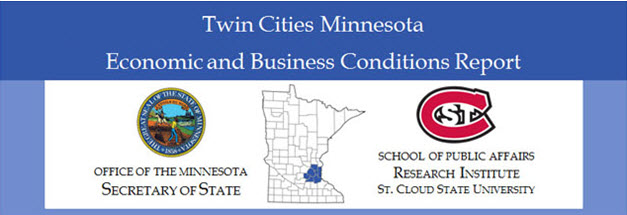Document Type
Research Study
Publication Date
1-2018
Abstract
Despite a third quarter decline in the Twin Cities Index of Leading Economic Indicators (LEI), economic growth is expected to remain steady in the Twin Cities over the next several months. The Twin Cities LEI registered a -5.41 reading in the third quarter after a revised 1.47 point decline in the previous quarter. Four of five index components turned down in the third quarter, with recent weakness in the Minnesota Business Conditions Index--a general measure of statewide business conditions—having the largest negative impact on the LEI. Increased new filings of business incorporation and LLC had a positive effect on the leading index.
There were 10,214 new business filings with the Office of the Minnesota Secretary of State in the seven-county metro area in the third quarter of 2017—representing an 11.1 percent increase from one year ago. There were 1,363 new regional business incorporations in the third quarter, 4.9 percent more than year ago levels. Third quarter new LLC filings rose to 6,508 in the seven-county metro area—a 16.8 percent increase compared to the third quarter of 2016. New assumed names were 0.7 percent higher in the third quarter and there were 2 more new non-profit filings in the Twin Cities than one year ago.
Sixty percent of new business filers in the Twin Cities planning area completed the voluntary Minnesota Business Snapshot (MBS) survey in this year’s third quarter. Results of this voluntary survey indicate that over 14 percent of new filers come from communities of color. About 4.3 percent of new filings are veterans. Less than 2 percent of new filers come from the disability community and 9.4 percent of new filings are made by the immigrant community. Thirty-five percent of new business filings in the Twin Cities planning area in this year’s third quarter were initiated by women. MBS results also show that most new business filers in the Twin Cities have between 0 and $10,000 in annual gross revenues (although 552 new filers have revenues in excess of $50,000). The most popular industries for new businesses in the Twin Cities are construction, retail trade, real estate/rental/leasing, professional/scientific/technical, and other services. Employment levels at most new firms are between 0 and 5 workers, and 44 percent of those starting a new business consider this a part-time activity.
Twin Cities planning area employment increased by 3.5 percent over the year ending September 2017. At 2.9 percent, the planning area’s unemployment rate was lower than one year earlier. Initial claims for unemployment insurance were lower than year ago levels, falling by 13.9 percent to 5,287. The ratio of job vacancies per 100 unemployed jumped to 132.05 in the Twin Cities in the most recent period for which data are available and average weekly work hours and average hourly earnings rose for private sector workers in the 16-county Minneapolis-St. Paul MSA over the year ending September 2017. The planning area labor force increased by 2.8 percent over the year ending September 2017. Annual bankruptcies have started to rise in the Twin Cities. The relative cost of living fell in Minneapolis but increased in St. Paul.
Recommended Citation
Banaian, King and MacDonald, Richard A., "Twin Cities Area Economic and Business Conditions Report Third Quarter 2017" (2017). Twin Cities Area Economic and Business Conditions Report. 15. http://repository.stcloudstate.edu/qebcr_tc_mn/15




